Characteristic and Geological Implications of Major Elements and Rare Earth Elements of Triassic Chang 7 Oil Shale in Tongchuan City, Southern Ordos Basin (China)
Abstract
:1. Introduction
2. Geological Setting
3. Samples and Methods
4. Results
4.1. Major Elements Characteristic
4.2. Rare Earth Elements Characteristic
4.3. Grain Size Parameters
5. Discussions
5.1. Geochemistry Implications of Major Elements
5.1.1. Paleoclimate
5.1.2. Hydrothermal Fluid Sedimentation
5.2. Geochemistry Implications of Rare Earth Elements
5.2.1. Diagenesis Stage
5.2.2. Paleo Aqueous Medium
5.2.3. Sedimentary Rate
5.2.4. The Provenance of Oil Shale and Orogeny Coupling Response
6. Conclusions
Acknowledgments
Author Contributions
Conflicts of Interest
References
- Hakimi, M.H.; Wan, H.A.; Alqudah, M.; Makeen, Y.M.; Mustapha, K.A. Organic geochemical and petrographic characteristics of the oil shales in the Lajjun area, Central Jordan: Origin of organic matter input and preservation conditions. Fuel 2016, 181, 34–45. [Google Scholar] [CrossRef]
- Song, Y.; Liu, Z.; Meng, Q.; Xu, J.; Sun, P.; Cheng, L.; Zheng, G. Multiple controlling factors of the enrichment of organic matter in the upper cretaceous oil shale sequences of the Songliao Basin, NE China: Implications from geochemical analyses. Oil Shale 2016, 33, 142–166. [Google Scholar] [CrossRef]
- Lv, D.W.; Li, Z.X.; Liu, H.Y.; Li, Y.; Feng, T.T.; Wang, D.D.; Wang, P.L.; Li, S.Y. The characteristics of coal and oil shale in the coastal sea areas of Huangxian Coalfield, Eastern China. Oil Shale 2015, 32, 204–207. [Google Scholar] [CrossRef]
- Li, D.; Li, R.; Zhu, Z.; Wu, X.; Cheng, J.; Liu, F.; Zhao, B. Origin of organic matter and paleo-sedimentary environment reconstruction of the Triassic oil shale in Tongchuan City, Southern Ordos Basin (China). Fuel 2017. [Google Scholar] [CrossRef]
- Li, D.; Li, R.; Zhu, Z.; Wu, X.; Liu, F.; Zhao, B.; Cheng, J.; Wang, B. Elemental characteristics and paleoenvironment reconstruction: A case study of the Triassic lacustrine Zhangjiatan oil shale, southern Ordos Basin, China. Acta Geochim. 2017. [Google Scholar] [CrossRef]
- Li, D.; Li, R.; Zhu, Z.; Wu, X.; Liu, F.; Zhao, B.; Wang, B. Influence on lacustrine source rock by hydrothermal fluid activities-a case study of oil shale from Chang 7 Oil layer in southern Ordos Basin. Acta Geochim. 2017. [Google Scholar] [CrossRef]
- Li, D.; Li, R.; Zhu, Z.; Wu, X.; Zhao, B.; Cheng, J.; Liu, F. Rare earth elements geochemistry characteristics and their geological implications of lacustrine oil shale from Chang 7 oil layer in southern Ordos Basin, China. Geol. J. 2017. [Google Scholar] [CrossRef]
- Bai, Y.L.; Ma, L.; Wu, J.W.; Ma, Y.H. Geological characteristics and resource potential of oil shale in Ordos Basin. Geol. China 2009, 36, 1123–1137. (In Chinese) [Google Scholar]
- Zhang, Q.C.; Wang, K.M.; Luo, S.S.; Wu, X.Z. Study on the Characteristics and Origin of the Oil Shale in the Chang 7 Member, Yanchang Formation in Ordos Basin. Adv. Geosci. 2013, 3, 197–209. (In Chinese) [Google Scholar] [CrossRef]
- Luo, Y.S.; Zhang, X.N.; Zhang, Z.H.; Deng, N.T.; He, Y.H.; Liang, Q.S. Favorable area forecast of oil shale exploration in southern Ordos basin. China Min. Mag. 2014, 23, 83–86. (In Chinese) [Google Scholar]
- Deng, N.T.; Zhang, Z.H.; Ren, L.Y.; Wang, F.B.; Liang, Q.S.; Li, Y.X.; Li, W.H.; Zhao, S.F.; Luo, M.J. Geochemical characteristics and distribution rules of oil shale from Yanchang Formation, Southern Ordos Basin. Pet. Geol. Exp. 2013, 35, 432–437. (In Chinese) [Google Scholar]
- Fu, X.; Jian, W.; Tan, F.; Feng, X.; Zeng, S. The geochemistry of trace elements in marine oil shales and their combustion residues: Occurrence and environmental aspects. Energy Sources 2016, 38, 410–419. [Google Scholar] [CrossRef]
- Wang, Z.; Fu, X.; Feng, X.; Song, C.; Wang, D.; Chen, W.; Zeng, S. Geochemical features of the black shales from the Wuyu Basin, southern Tibet: Implications for palaeoenvironment and palaeoclimate. Geol. J. 2017, 52, 282–297. [Google Scholar] [CrossRef]
- Qiu, X.; Liu, C.; Mao, G.; Deng, Y.; Wang, F.; Wang, J. Major, trace and platinum-group element geochemistry of the Upper Triassic nonmarine hot shales in the Ordos basin, Central China. Appl. Geochem. 2015, 53, 42–52. [Google Scholar] [CrossRef]
- Fathy, D.; Wagreich, M.; Zaki, R.; Mohamed, R.S.A.; Gier, S. Geochemical fingerprinting of maastrichtian oil shales from the central eastern desert, egypt: Implications for provenance, tectonic setting, and source area weathering. Geol. J. 2017, 1–16. [Google Scholar] [CrossRef]
- Qiu, X.W.; Liu, C.Y.; Wang, F.F.; Deng, Y.; Mao, G.Z. Trace and rare earth element geochemistry of the Upper Triassic mudstones in the southern Ordos Basin, Central China. Geol. J. 2015, 50, 399–413. [Google Scholar] [CrossRef]
- Sun, S.S.; Yao, Y.B.; Lin, W. Elemental Geochemical Characteristics of the Oil Shale and the Paleo-Lake Environment of the Tongchuan Area, Southern Ordos Basin. Bull. Miner. Petrol. Geochem. 2015, 34, 642–645. (In Chinese) [Google Scholar]
- Ma, Z.H.; Chen, Q.S.; Shi, Z.W.; Wang, C.; Du, W.G.; Zhao, C.Y. Geochemistry of oil shale from Chang 7 reservoir of Yanchang Formation in south Ordos Basin and its geological significance. Geol. Bull. China 2016, 35, 1550–1558. (In Chinese) [Google Scholar]
- Yang, H.; Niu, X.B.; Xu, L.M.; Feng, S.B.; You, Y.; Liang, X.W.; Wang, F.; Zhang, D.D. Exploration potential of shale oil in Chang7 Member, Upper Triassic Yanchang Formation, Ordos Basin, NW China. Pet. Explor. Dev. 2016, 43, 511–520. (In Chinese) [Google Scholar] [CrossRef]
- Li, D.; Li, R.; Wang, B.; Liu, Z.; Wu, X.; Liu, F.; Zhao, B. Study on oil-source correlation by analyzing organic geochemistry characteristics: A case study of the Upper Triassic Yanchang Formation in the south of Ordos Basin, China. Acta Geochim. 2016, 35, 1–13. [Google Scholar] [CrossRef]
- Wang, J.Q.; Liu, C.Y.; Guo, Z.; Zhang, D.D. Sedimentary response of regional tectonic transformation in Late Triassic Yanchang period at the central and southern Ordos Basin. Earth Sci. Front. 2015, 22, 194–204. (In Chinese) [Google Scholar]
- Wan, Y.S.; Xie, H.Q.; Yang, H.; Wang, A.J.; Liu, D.Y.; Kröner, A.; Wilde, S.A.; Geng, Y.S.; Sun, L.Y.; Ma, M.Z.; et al. Is the Ordos block Archean or Paleoproterozoic in age? Implications for the Precambrian evolution of the North China craton. Am. J. Sci. 2013, 313, 683–711. [Google Scholar] [CrossRef]
- Wang, X.F. Non-Seismic Oil and Gas Exploration in Ordos Basin; Geological Publishing House: Beijing, China, 1992. (In Chinese) [Google Scholar]
- Liu, S.F. The coupling mechanism of basin and orogen in the western Ordos basin and adjacent regions of China. J. Asian Earth Sci. 1998, 16, 369–383. [Google Scholar] [CrossRef]
- Liu, S.; Yang, S. Upper Triassic-Jurassic sequence stratigraphy and its structural controls in the western Ordos basin, China. Basin Res. 2000, 12, 1–18. [Google Scholar] [CrossRef]
- Qiu, X.W.; Liu, C.Y.; Mao, G.Z.; Deng, Y.; Wang, F.F. Enrichment feature of thorium element in tuff interlayers of Upper Triassic Yanchang Formation in Ordos Basin, China. Geol. Bull. China 2010, 29, 1185–1191. (In Chinese) [Google Scholar]
- Methods for Chemical Analysis of Silicate Rocks; GB/T14506.1~14-2010; Standards Press of China: Beijing, China, 2010. (In Chinese)
- Methods for Chemical Analysis of Silicate Rocks-Part 30: Determination of 44 Elements; GB/T14506.30-2010; Standards Press of China: Beijing, China, 2010. (In Chinese)
- Folk, R.L. Petrology of Sedimentary Rocks; Hemphills Publ Co.: Austin, TX, USA, 1980; p. 170. [Google Scholar]
- Griffiths, J.C. Size versus sorting in Caribbean sediments. J. Geol. 1951, 59, 211–243. [Google Scholar] [CrossRef]
- Calvert, S.E.; Pedersen, T.F.; Karlin, R.E. Geochemical and isotopic evidence for post-glacial palaeoceanographic changes in Saanich Inlet, British Columbia. Mar. Geol. 2001, 174, 287–305. [Google Scholar] [CrossRef]
- Blott, S.J.; Pye, K. GRADISTAT: A grain size distribution and statistics package for the analysis of unconsolidated sediments. Earth Surface Process. Landf. 2001, 26, 1237–1248. [Google Scholar] [CrossRef]
- Fu, X.; Wang, J.; Zeng, Y.; Tan, F.; Chen, W.; Feng, X. Geochemistry of rare earth elements in marine oil shale—A case study from the Bilong Co area, Northern Tibet, China. Oil Shale 2010, 27, 194–208. [Google Scholar] [CrossRef]
- Fu, X.; Wang, J.; Zeng, Y.; Tan, F.; Feng, X. REE geochemistry of marine oil shale from the Changshe Mountain area, northern Tibet, China. Int. J. Coal Geol. 2010, 81, 191–199. [Google Scholar] [CrossRef]
- Chen, J.F.; Sun, X.L. Preliminary study of geochemical characteristics and formation-of organic matter rich stratigraphy of Xiamaling-Formation of later Proterozoic in North China. Natl. Gas Geosci. 2004, 15, 110–114. (In Chinese) [Google Scholar]
- He, C.; Ji, L.; Wu, Y.; Wu, Y.; Ao, S.; Zhang, M. Characteristics of Hydrothermal Sedimentation Process in the Yanchang Formation, South Ordos Basin, China: Evidence from Element Geochemistry. Sediment. Geol. 2016, 345, 33–41. [Google Scholar] [CrossRef]
- Herron, M.M. Geochemical classification of terrigenous sands and shales from core or log data. J. Sediment. Res. 1988, 58, 820–829. [Google Scholar]
- Wang, D.Y.; Xin, B.S.; Yang, H.; Fu, J.H.; Yao, J.L.; Zhang, Y. Zircon SHRIMP U-Pb age and geological implications of tuff at the bottom of Chang-7 Member of Yanchang Formation in the Ordos Basin. Sci. China Earth Sci. 2014, 44, 2160–2171. [Google Scholar] [CrossRef]
- Tu, Q.J.; Xu, S.Q. The REE Geochemistry of the Lucaogou Formation in the Southern Junggar Basin and Analysis of Parent Rock and Tectonic Setting in Sediment-source Region. Xin Jiang Geol. 2016, 34, 345–349. (In Chinese) [Google Scholar]
- Taylor, S.R.; Mclennan, S.M. The geochemical evolution of the continental crust. Rev. Geophys. 1995, 33, 293–301. [Google Scholar] [CrossRef]
- Rudnick, R.; Gao, S. 4.1-Composition of the Continental Crust. Treat. Geochem. 2014, 4, 1–64. [Google Scholar]
- Passega, R. Texture as Characteristic of Clastic Deposition; University of Cambridge: Cambridge, UK, 1957. [Google Scholar]
- Madhavaraju, J. Chapter 8-Geochemistry of Late Cretaceous Sedimentary Rocks of the Cauvery Basin, South India: Constraints on Paleoweathering, Provenance, and End Cretaceous Environments. Chemostratigraphy 2015, 185–214. [Google Scholar] [CrossRef]
- Madhavaraju, J.; Tom, M.; Lee, Y.I.; Balaram, V.; Ramasamy, S.; Carranza-Edwards, A.; Ramachandran, A. Provenance and tectonic settings of sands from Puerto Peñasco, Desemboque and Bahia Kino beaches, Gulf of California, Sonora, Mexico. J. S. Am. Earth Sci. 2016, 71, 262–275. [Google Scholar] [CrossRef]
- Mondal, M.E.A.; Wani, H.; Mondal, B. Geochemical signature of provenance, tectonics and chemical weathering in the Quaternary flood plain sediments of the Hindon River, Gangetic plain, India. Tectonophysics 2012, 566–567, 87–94. [Google Scholar] [CrossRef]
- Ramachandran, A.; Madhavaraju, J.; Ramasamy, S.; Lee, Y.I.; Rao, S.; Chawngthu, D.L.; Velmurugan, K. Geochemistry of Proterozoic clastic rocks of the Kerur Formation of Kaladgi-Badami Basin, North Karnataka, South India: Implications for paleoweathering and provenance. Turk. J. Earth Sci. 2016, 25, 126–144. [Google Scholar] [CrossRef]
- Young, G.M.; Nesbitt, H.W. Paleoclimateology and Provenance of the glaciogenic Gowganda Formation (Paleoproterozoic), Ontario, Canda: A chemostratigraphic approach. GSA Bull. 1999, 111, 264–274. [Google Scholar] [CrossRef]
- Feng, L.; Chu, X.; Zhang, Q.; Zhang, T.; Li, H.; Jiang, N. New evidence of deposition under cold climate for the Xieshuihe Formation of the Nanhua System in northwestern Hunan, China. Sci. Bull. 2004, 49, 1420–1427. [Google Scholar] [CrossRef]
- Li, D.; Li, R.; Zhu, Z.; Xu, F. Elemental characteristics of lacustrine oil shale and its controlling factors of palaeo-sedimentary environment on oil yield a case from Chang 7 oil layer of Triassic Yanchang Formation in southern Ordos Basin. Acta Geochim. 2017. [Google Scholar] [CrossRef]
- Cullers, R.L.; Podkovyrov, V.N. Geochemistry of the Mesoproterozoic Lakhanda shales in southeastern Yakutia, Russia: Implications for mineralogical and provenance control, and recycling. Precambrian Res. 2000, 104, 77–93. [Google Scholar] [CrossRef]
- He, C.; Ji, L.M.; Su, A.; Liu, Y.; Li, J.F.; Wu, Y.D.; Zhang, M.Z. Relationship between hydrothermal sedimentation process and source rock development in the Yanchang Formation, southern Ordos Basin. Earth Sci. Front. 2017. [Google Scholar] [CrossRef]
- Michard, A.; Albarede, F.; Michard, G.; Minister, J.F.; Charlow, J.L. Rare earth elements and uranium in high temperature solutions from East-Pacific rise hydrothermal vent field (13°N). Nature 1983, 303, 795–797. [Google Scholar] [CrossRef]
- Sherrell, R.M.; Field, M.P.; Ravizza, G. Uptake and fractionation of rare earth elements on hydrothermal plume particles at 945′ N, East Pacific Rise. Geochim. Cosmochim. Acta 1999, 63, 1709–1722. [Google Scholar] [CrossRef]
- Chu, C.L.; Chen, Q.L.; Zhang, B.; Shi, Z.; Jiang, H.J.; Yang, X. Influence on Formation of Yuertusi Source Rock by Hydrothermal Activities at Dongergou Section, Tarim Basin. Acta Sedimentol. Sin. 2016, 34, 803–810. (In Chinese) [Google Scholar]
- Jia, Z.B.; Hou, D.J.; Sun, D.Q.; Huang, Y.X. Hydrothermal sedimentary discrimination criteria and its coupling relationship with the source rocks. Natl. Gas Geosci. 2016, 27, 1025–1034. (In Chinese) [Google Scholar]
- Shields, G.; Stille, P. Diagenetic constraints on the use of cerium anormalies as paleoseawater redox proxies: An isotope and REE study of Cambrian phosphorites. Chem. Geol. 2001, 175, 29–48. [Google Scholar] [CrossRef]
- The Division of Diagenetic Stages in Clastic Rocks; SY/T 5477-2003; Standards Press of China: Beijing, China, 2003. (In Chinese)
- German, C.R.; Elderfield, H. Application of Ce anomaly as a paleo redox indicator: The ground rules. Paleoceanography 1990, 5, 823–833. [Google Scholar] [CrossRef]
- Grandjean, P.; Cappetta, H.; Albarède, F. The REE and Nd of 40–70 Ma old fish debris from the West-African platform. Geophys. Res. Lett. 1988, 15, 389–392. [Google Scholar] [CrossRef]
- Grandjean, P.; Cappetta, H.; Michard, A.; Albarede, F. The assessment of REE patterns and 143Nd/144Nd ratios in fish remains. Earth Planet. Sci. Lett. 1987, 84, 181–196. [Google Scholar] [CrossRef]
- Liu, Y.G.; Miah, M.R.U.; Schmitt, R.A. Cerium: A chemical tracer for paleo-oceanic redox conditions. Geochim. Cosmochim. Acta 1988, 52, 1361–1371. [Google Scholar] [CrossRef]
- Madhavaraju, J.; Loser, H.; Lee, Y.I.; Santacruz, R.L.; Pi-Puig, T. Geochemistry of Lower Cretaceous limestones of the Alisitos Formation, Baja California, Mexico: Implications for REE source and paleo-redox conditions. J. S. Am. Earth Sci. 2016, 66, 149–165. [Google Scholar] [CrossRef]
- Madhavaraju, J.; Loser, H.; Scott, R.W.; Sandeep, S.; Sial, A.N.; Ramasamy, S. Petrography, geochemistry and stable isotopes of carbonate rocks, Lower Cretaceous Alisitos Formation, Los Torotes section, Baja California, Mexico. Rev. Mex. Cienc. Geol. 2017, 34, 63–77. [Google Scholar] [CrossRef]
- Chen, B.H.; Wei, H.X.; Huang, Z.G.; Zhou, Y.Z. Cerium anomalies in supergene geological bodies and its effecting factors. Chin. Rare Earths 2007, 28, 79–83. (In Chinese) [Google Scholar]
- Peng, X.F.; Wang, L.J.; Jiang, L.P. Geochemical Characteristics of the Lucaogou Formation Oil Shale in the Southeastern Margin of the Junggar Basin and Its Environmental Implications. Bull. Mineral. Petrol. Geochem. 2012, 31, 121–127. (In Chinese) [Google Scholar]
- Wang, G.; Chen, H.; Zhu, Z.; Lin, L.; Fan, Y. The characteristics and geological implications of rare earth elements in sandstone of lower Silurian Xiaoheba Formation in the southeastern Sichuan-western Hunan. Petrol. Geol. Exp. 2010, 32, 487–495. (In Chinese) [Google Scholar]
- Li, S.J.; Xiao, K.H.; Wo, Y.J.; Long, S.X.; Cai, L.G. REE Geochemical Characteristics and Their Geological Signification in Silurian, West of Hunan Province and North of Guizhou Province. Geoscience 2008, 22, 273–280. (In Chinese) [Google Scholar]
- Wang, J.Q.; Liu, C.Y.; Li, X.; Wu, T.T.; Wu, J.L. Geochronology, Potential Source and Regional Implications of Tuff Intervals in Chang-7 Member of Yanchang Formation, South of Ordos Basin. Acta Sedimentol. Sin. 2017, 35, 692–704. [Google Scholar] [CrossRef]
- Wang, X.X.; Zheng, R.C.; Yan, G.Q.; Wang, C.Y.; Chen, H.R. The Mudstone Sedimentary Environment and Provenance Analysis Based on the Geochemical Evidence of Rare Earth Elements: Take Chang 9 Oil-bearing Layer in Longdong Area of Ordos Basin as an Example. Natl. Gas Geosci. 2014, 25, 1387–1394. (In Chinese) [Google Scholar]
- Yang, H.; Zhang, W.Z. Leading effect of the Seventh Member high-quality source rock of Yanchang Formation in Ordos Basin during the enrichment of low-penetrating oil-gas accumulation: Geology and geochemistry. Geochimica 2005, 34, 147–154. (In Chinese) [Google Scholar]
- Zhang, W.Z.; Yang, H.; Yang, Y.H.; Kong, Q.F.; Wu, K. Petrology and element geochemistry and development environment of Yanchang Formation Chang-7 high quality source rocks in Ordos Basin. Geochimica 2008, 37, 59–64. [Google Scholar]
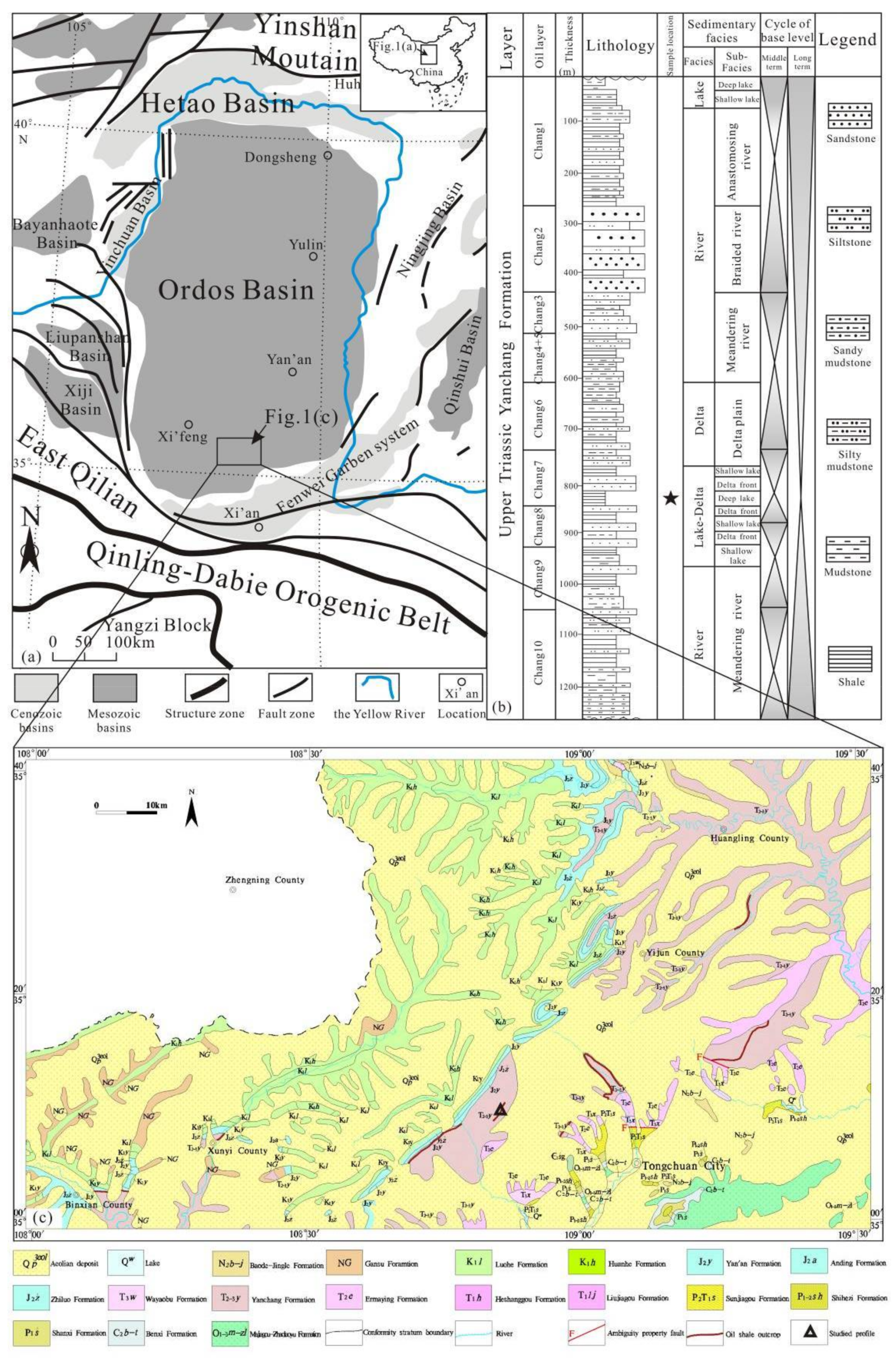

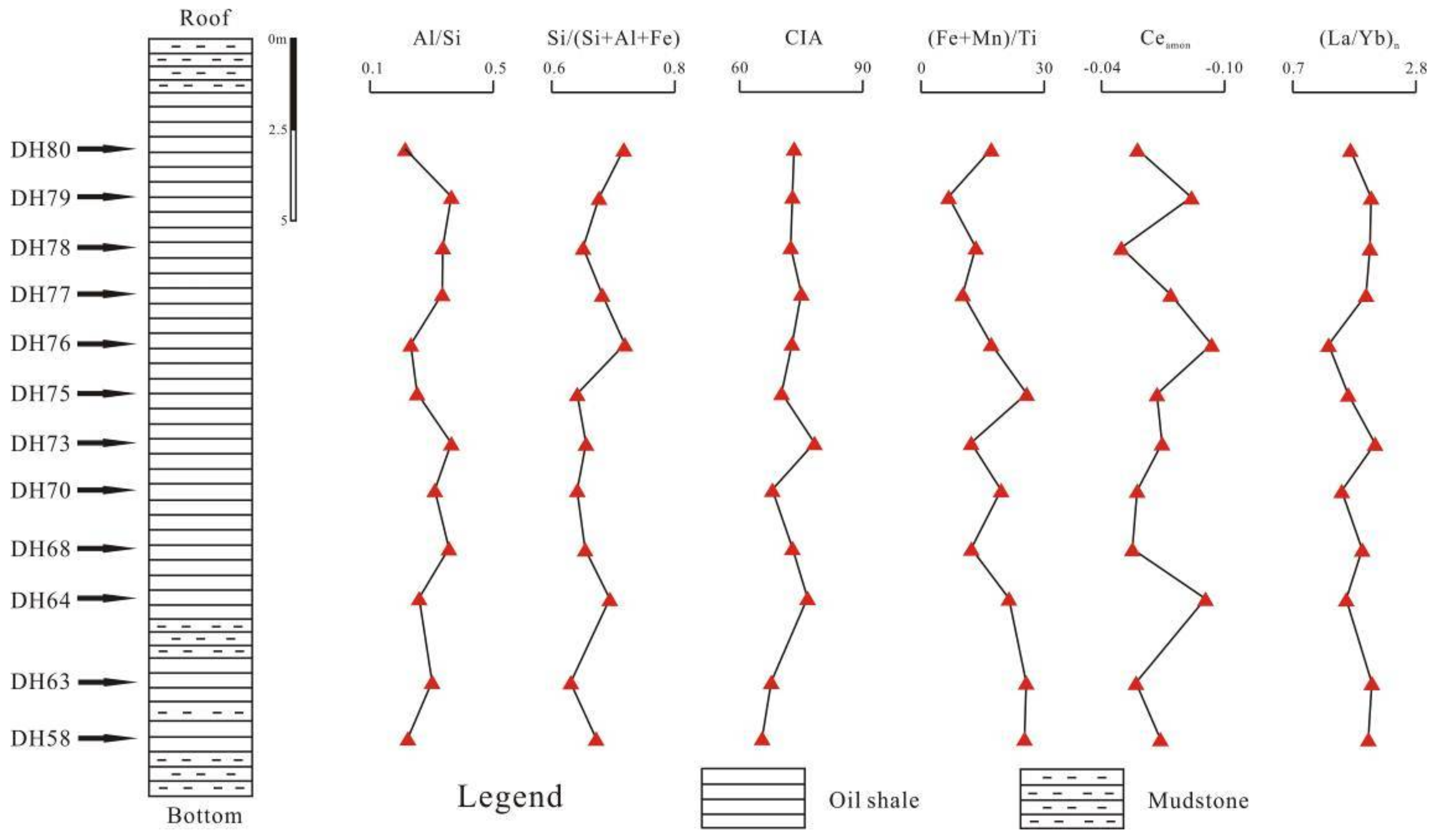
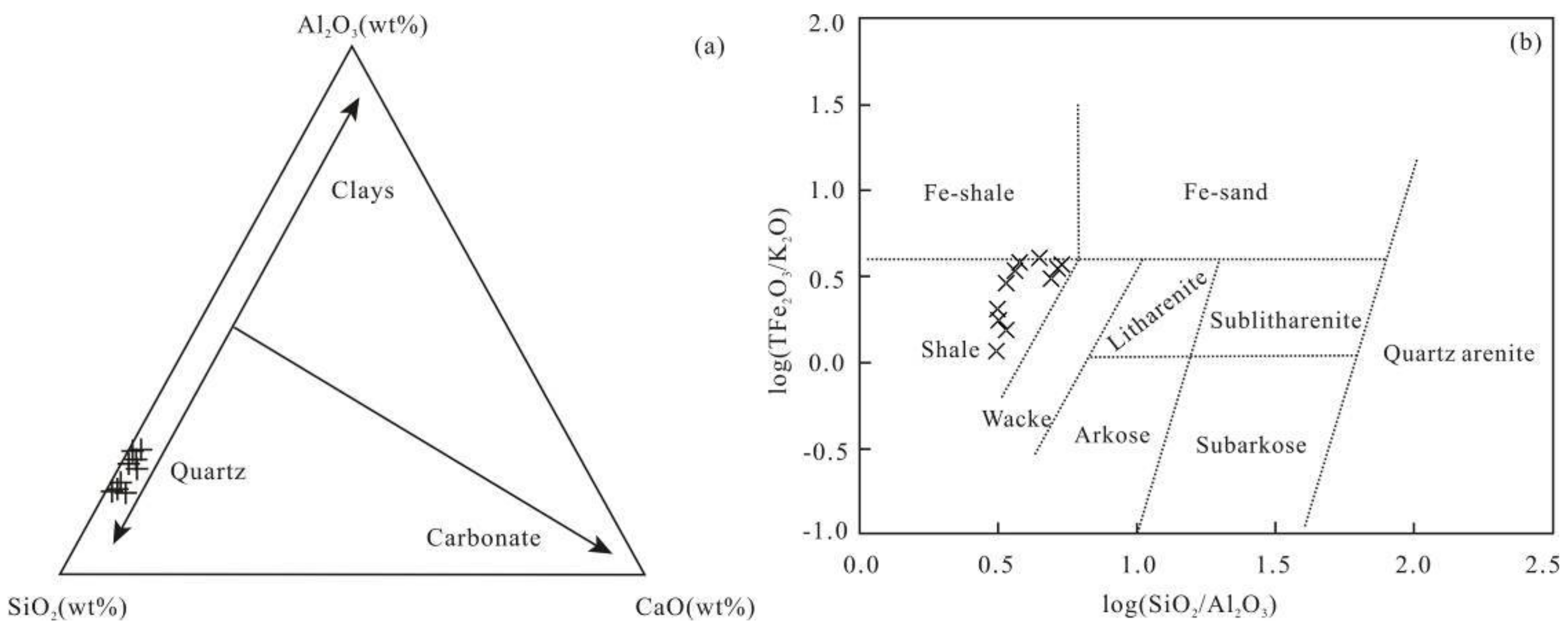
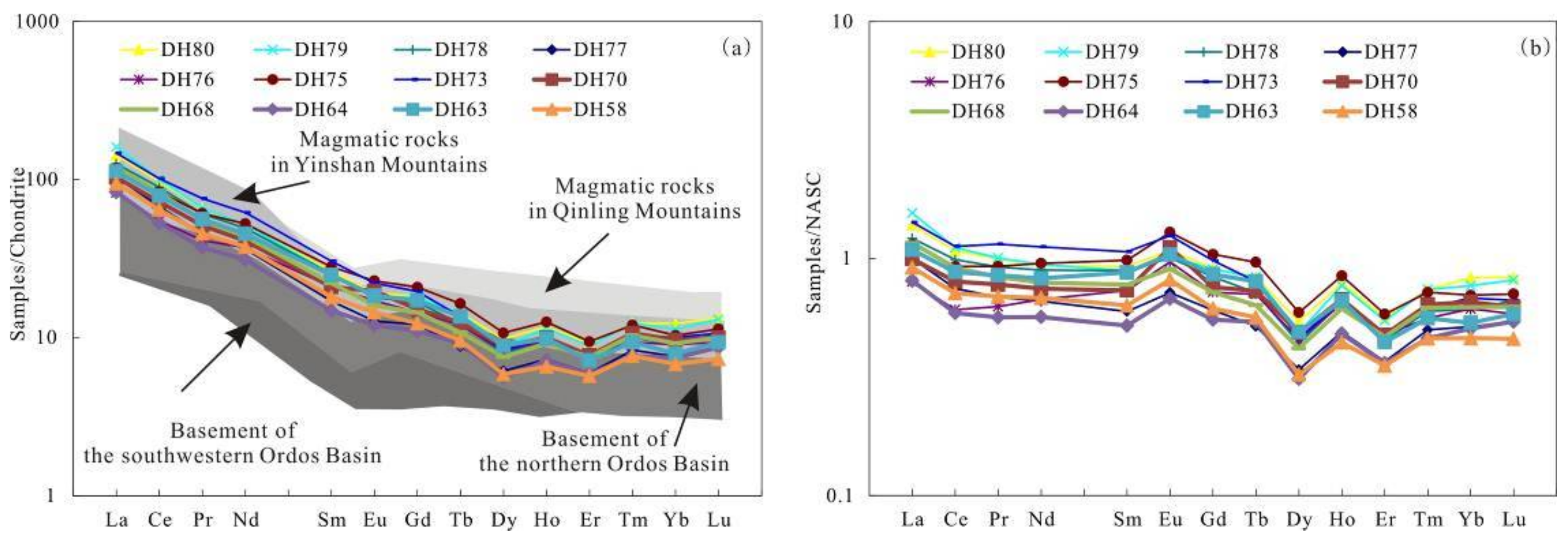

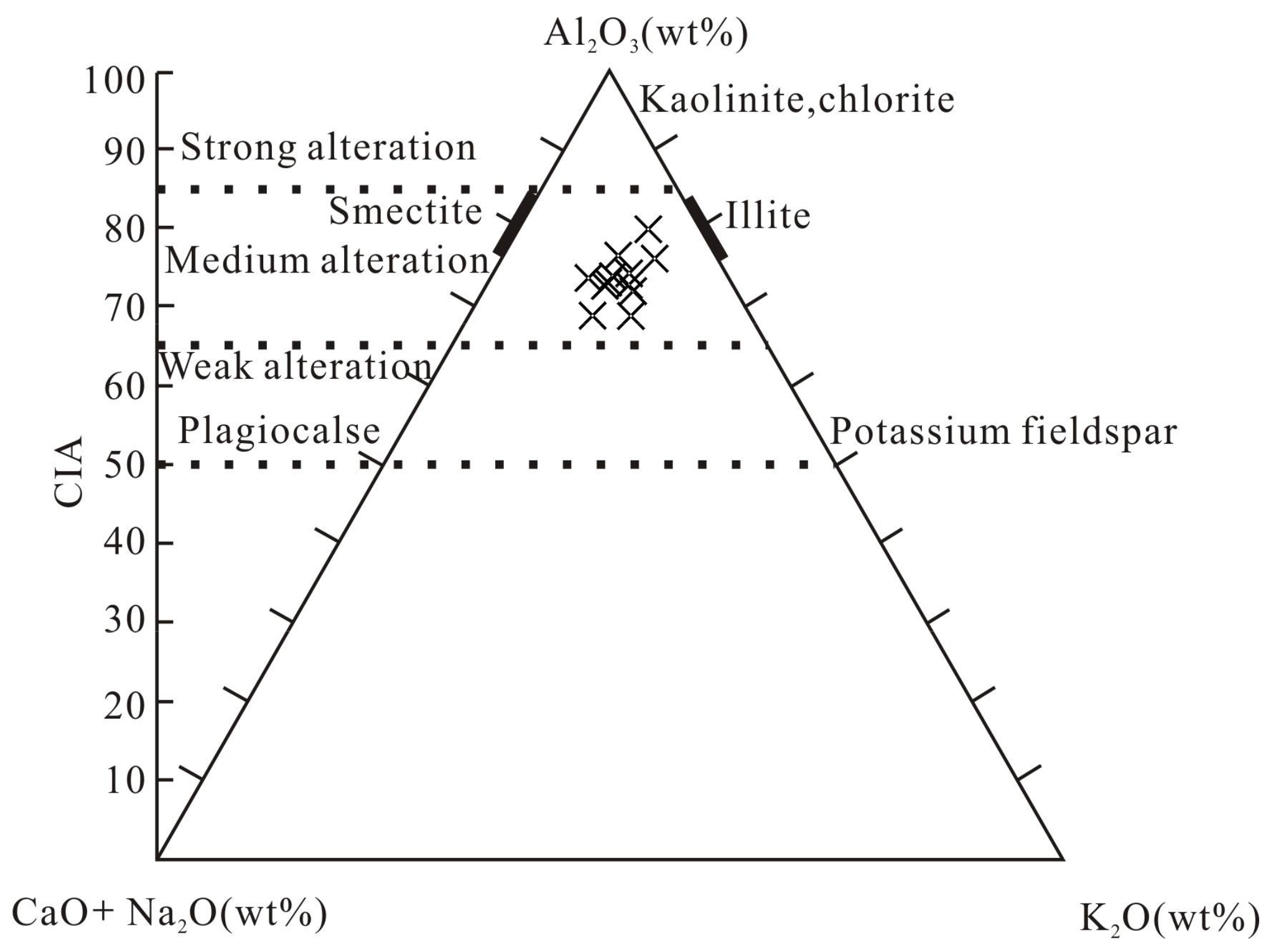

| Samples ID | SiO2 | Al2O3 | TFe2O3 | MgO | CaO | Na2O | K2O | P2O5 | MnO | TiO2 |
|---|---|---|---|---|---|---|---|---|---|---|
| DH80 | 56.60 | 10.52 | 6.95 | 0.51 | 1.29 | 0.57 | 1.85 | 0.21 | 0.01 | 0.48 |
| DH79 | 48.66 | 15.61 | 3.65 | 1.08 | 1.68 | 0.77 | 3.13 | 0.14 | 0.03 | 0.65 |
| DH78 | 51.21 | 14.99 | 7.02 | 0.81 | 1.25 | 0.96 | 2.43 | 0.20 | 0.02 | 0.62 |
| DH77 | 45.70 | 13.38 | 4.10 | 0.68 | 1.51 | 0.50 | 2.66 | 0.11 | 0.03 | 0.48 |
| DH76 | 48.95 | 9.88 | 5.37 | 0.48 | 1.37 | 0.56 | 1.75 | 0.12 | 0.01 | 0.37 |
| DH75 | 50.43 | 11.21 | 10.34 | 0.57 | 1.22 | 0.62 | 2.55 | 0.29 | 0.07 | 0.47 |
| DH73 | 51.48 | 16.20 | 5.83 | 0.76 | 0.55 | 0.71 | 2.85 | 0.30 | 0.01 | 0.56 |
| DH70 | 53.29 | 14.50 | 8.86 | 0.61 | 1.04 | 1.85 | 2.60 | 0.34 | 0.02 | 0.53 |
| DH68 | 53.24 | 16.60 | 6.24 | 1.02 | 0.75 | 0.86 | 3.63 | 0.18 | 0.01 | 0.60 |
| DH64 | 39.56 | 8.86 | 4.95 | 0.46 | 1.48 | 0.43 | 1.24 | 0.16 | 0.02 | 0.27 |
| DH63 | 43.27 | 11.42 | 8.30 | 0.78 | 1.99 | 0.95 | 2.18 | 0.30 | 0.04 | 0.38 |
| DH58 | 45.00 | 8.72 | 8.00 | 0.49 | 0.75 | 0.98 | 2.24 | 0.30 | 0.01 | 0.37 |
| Average | 48.95 | 12.66 | 6.63 | 0.69 | 1.24 | 0.81 | 2.43 | 0.22 | 0.02 | 0.48 |
| Samples ID | La | Ce | Pr | Nd | Sm | Eu | Gd | Tb | Dy | Ho | Er | Tm | Yb | Lu | ΣLREE | ΣHREE | ΣREE |
|---|---|---|---|---|---|---|---|---|---|---|---|---|---|---|---|---|---|
| DH80 | 44.20 | 78.80 | 7.87 | 30.80 | 5.28 | 1.34 | 4.74 | 0.71 | 3.14 | 0.82 | 1.92 | 0.37 | 2.57 | 0.4 | 168.29 | 14.67 | 182.96 |
| DH79 | 49.70 | 81.20 | 7.94 | 31.10 | 5.06 | 1.27 | 4.68 | 0.71 | 2.82 | 0.8 | 1.86 | 0.37 | 2.38 | 0.39 | 176.27 | 14.01 | 190.28 |
| DH78 | 38.90 | 72.20 | 7.27 | 29.50 | 5.07 | 1.25 | 4.35 | 0.61 | 2.54 | 0.68 | 1.54 | 0.3 | 1.88 | 0.32 | 154.19 | 12.22 | 166.41 |
| DH77 | 32.00 | 54.60 | 5.43 | 21.80 | 3.41 | 0.89 | 3.15 | 0.44 | 1.97 | 0.51 | 1.25 | 0.25 | 1.6 | 0.26 | 118.13 | 9.43 | 127.56 |
| DH76 | 25.50 | 44.40 | 4.95 | 22.20 | 4.18 | 1.20 | 3.75 | 0.60 | 2.64 | 0.67 | 1.62 | 0.28 | 1.9 | 0.28 | 102.43 | 11.74 | 114.17 |
| DH75 | 36.60 | 67.60 | 7.32 | 31.50 | 5.61 | 1.60 | 5.42 | 0.82 | 3.43 | 0.88 | 1.98 | 0.36 | 2.17 | 0.34 | 150.23 | 15.40 | 165.63 |
| DH73 | 45.50 | 82.20 | 9.09 | 37.00 | 6.09 | 1.55 | 5.10 | 0.68 | 2.67 | 0.69 | 1.65 | 0.31 | 2.11 | 0.32 | 181.43 | 13.53 | 194.96 |
| DH70 | 31.90 | 58.40 | 6.14 | 24.60 | 4.18 | 1.38 | 3.94 | 0.62 | 2.82 | 0.7 | 1.62 | 0.32 | 2.03 | 0.3 | 126.60 | 12.35 | 138.95 |
| DH68 | 37.20 | 66.80 | 6.60 | 26.10 | 4.42 | 1.12 | 3.75 | 0.54 | 2.42 | 0.64 | 1.59 | 0.31 | 1.93 | 0.3 | 142.24 | 11.48 | 153.72 |
| DH64 | 25.80 | 43.00 | 4.46 | 18.70 | 2.97 | 0.84 | 2.87 | 0.46 | 1.80 | 0.5 | 1.23 | 0.23 | 1.57 | 0.26 | 95.77 | 8.92 | 104.69 |
| DH63 | 34.80 | 64.00 | 6.72 | 27.20 | 4.98 | 1.29 | 4.46 | 0.68 | 2.84 | 0.69 | 1.51 | 0.28 | 1.66 | 0.28 | 138.99 | 12.40 | 151.39 |
| DH58 | 29.30 | 52.20 | 5.46 | 22.50 | 3.61 | 1.01 | 3.20 | 0.48 | 1.88 | 0.46 | 1.2 | 0.23 | 1.43 | 0.22 | 114.08 | 9.10 | 123.18 |
| Chondrite a | 0.31 | 0.81 | 0.12 | 0.6 | 0.2 | 0.07 | 0.26 | 0.05 | 0.32 | 0.07 | 0.21 | 0.03 | 0.21 | 0.03 | 2.11 | 1.18 | 3.29 |
| NASC b | 32 | 73 | 7.9 | 33 | 5.7 | 1.24 | 5.2 | 0.85 | 5.8 | 1.04 | 3.4 | 0.5 | 3.1 | 0.48 | 152.84 | 20.37 | 173.21 |
| Average | 35.95 | 63.78 | 6.60 | 26.92 | 4.57 | 1.23 | 4.12 | 0.61 | 2.58 | 0.67 | 1.58 | 0.30 | 1.94 | 0.31 | 139.05 | 12.10 | 151.16 |
| Samples ID | Al/Si | Si/(Si + Al + Fe) | ICV | CIA | Ceanom | (Fe + Mn)/Ti | L/H | (La/Yb)N | (La/Sm)N | (Gd/Yb)N | (La/Yb)n | (Dy/Sm)N | δCeN |
|---|---|---|---|---|---|---|---|---|---|---|---|---|---|
| DH80 | 0.21 | 0.72 | 0.97 | 73.04 | −0.057 | 16.91 | 11.47 | 11.65 | 5.40 | 1.49 | 1.67 | 0.37 | 1.01 |
| DH79 | 0.36 | 0.68 | 0.76 | 72.47 | −0.084 | 6.60 | 12.58 | 14.15 | 6.34 | 1.59 | 2.02 | 0.35 | 0.97 |
| DH78 | 0.33 | 0.65 | 0.88 | 72.12 | −0.049 | 13.24 | 12.62 | 14.02 | 4.95 | 1.87 | 2.00 | 0.31 | 1.02 |
| DH77 | 0.33 | 0.68 | 0.71 | 74.70 | −0.074 | 10.03 | 12.53 | 13.55 | 6.05 | 1.59 | 1.94 | 0.36 | 0.99 |
| DH76 | 0.23 | 0.72 | 0.90 | 72.53 | −0.094 | 16.96 | 8.72 | 9.09 | 3.94 | 1.59 | 1.30 | 0.39 | 0.94 |
| DH75 | 0.25 | 0.64 | 1.21 | 69.99 | −0.067 | 25.82 | 9.76 | 11.43 | 4.21 | 2.02 | 1.63 | 0.38 | 0.98 |
| DH73 | 0.36 | 0.65 | 0.67 | 78.09 | −0.070 | 12.16 | 13.41 | 14.61 | 4.82 | 1.95 | 2.09 | 0.27 | 0.96 |
| DH70 | 0.31 | 0.64 | 1.02 | 67.61 | −0.057 | 19.54 | 10.25 | 10.65 | 4.92 | 1.57 | 1.52 | 0.42 | 0.99 |
| DH68 | 0.35 | 0.65 | 0.82 | 72.52 | −0.055 | 12.15 | 12.39 | 13.06 | 5.43 | 1.57 | 1.87 | 0.34 | 1.02 |
| DH64 | 0.25 | 0.69 | 0.84 | 76.25 | −0.091 | 21.47 | 10.74 | 11.13 | 5.60 | 1.48 | 1.59 | 0.38 | 0.95 |
| DH63 | 0.30 | 0.63 | 1.17 | 67.53 | −0.057 | 25.59 | 11.21 | 14.20 | 4.51 | 2.17 | 2.03 | 0.36 | 1.00 |
| DH58 | 0.22 | 0.67 | 1.32 | 65.02 | −0.069 | 25.25 | 12.54 | 13.88 | 5.24 | 1.81 | 1.98 | 0.33 | 0.98 |
| Average | 0.29 | 0.67 | 0.94 | 71.82 | −0.069 | 17.15 | 11.52 | 12.62 | 5.12 | 1.72 | 1.80 | 0.36 | 0.98 |
| Sample ID | C | M | Phi1 | Phi5 | Phi10 | Phi16 | Phi25 | Phi50 | Phi75 | Phi84 | Phi90 | Phi95 | Mz |
|---|---|---|---|---|---|---|---|---|---|---|---|---|---|
| LD52 | 115.82 | 59.54 | 3.11 | 3.52 | 3.60 | 3.69 | 3.81 | 4.07 | 4.31 | 4.42 | 4.49 | 4.77 | 4.09 |
| LD55 | 135.84 | 75.36 | 2.88 | 3.10 | 3.26 | 3.34 | 3.46 | 3.73 | 4.05 | 4.22 | 4.38 | 4.56 | 3.77 |
| LD57 | 137.74 | 67.45 | 2.86 | 3.32 | 3.46 | 3.54 | 3.63 | 3.89 | 4.21 | 4.36 | 4.48 | 4.63 | 3.92 |
| LD60 | 136.79 | 76.95 | 2.87 | 3.05 | 3.14 | 3.24 | 3.37 | 3.70 | 4.02 | 4.17 | 4.29 | 4.44 | 3.71 |
© 2018 by the authors. Licensee MDPI, Basel, Switzerland. This article is an open access article distributed under the terms and conditions of the Creative Commons Attribution (CC BY) license (http://creativecommons.org/licenses/by/4.0/).
Share and Cite
Li, D.; Li, R.; Xue, T.; Wang, B.; Liu, F.; Zhao, B.; Zhao, D. Characteristic and Geological Implications of Major Elements and Rare Earth Elements of Triassic Chang 7 Oil Shale in Tongchuan City, Southern Ordos Basin (China). Minerals 2018, 8, 157. https://doi.org/10.3390/min8040157
Li D, Li R, Xue T, Wang B, Liu F, Zhao B, Zhao D. Characteristic and Geological Implications of Major Elements and Rare Earth Elements of Triassic Chang 7 Oil Shale in Tongchuan City, Southern Ordos Basin (China). Minerals. 2018; 8(4):157. https://doi.org/10.3390/min8040157
Chicago/Turabian StyleLi, Delu, Rongxi Li, Tao Xue, Baoping Wang, Futian Liu, Bangsheng Zhao, and Di Zhao. 2018. "Characteristic and Geological Implications of Major Elements and Rare Earth Elements of Triassic Chang 7 Oil Shale in Tongchuan City, Southern Ordos Basin (China)" Minerals 8, no. 4: 157. https://doi.org/10.3390/min8040157




